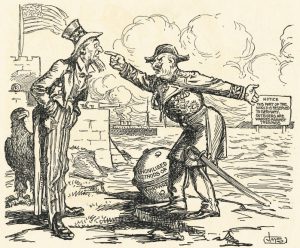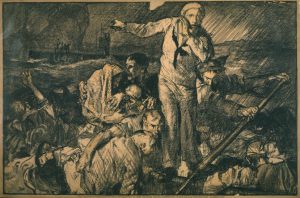If it hadn’t been for the Kaiser, February and March of 1917 in Genesee County would’ve echoed almost any earlier year’s transition from winter to spring in western New York.
February’s first days brought brutal winds, record cold, and snow measured in feet, not inches.
[Click on articles for full view in separate tab]
——
“Engines Were Buried All Day in about Eighteen Feet of Snow”
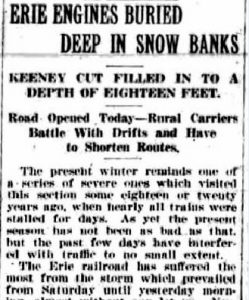 February 7, 1917 LeRoy Gazette-News
February 7, 1917 LeRoy Gazette-News
“The storm, which started on Friday night with some snow and a strong north wind, continued almost unabated until yesterday,” reported the Wednesday, February 7 LeRoy Gazette-News. “Saturday was one of the worst days here this winter. The temperature in the morning was two to eight degrees below zero and the wind which blew at a 40-mile clip all day drove the cold into buildings, making it difficult to heat them. On Sunday more snow fell. . . . The wind came up again and continued without let up until yesterday noon.”
“Low Temperature Records for this Winter were Broken this Morning”
February 12, 1917 Batavia Daily News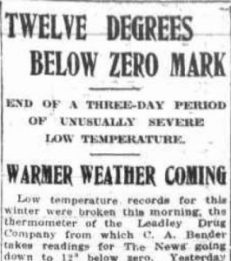
“The high school was not in session this morning, owing to the low temperature in the rooms, although the heating plant was operated to its capacity. . . . Joshua R Houseknecht of the Batavia-Stafford townline road reported that the mercury registered 20 below zero at 5:45 o’clock and it was 18 below at 8 o’clock this morning on his farm.”
But western New Yorkers always have been a hardy lot, not the sort to let a little cold and snow get the best of them, and 1917 was no exception. “Those who bundled up well and kept moving did not suffer,” observed the Daily News in that February 12 article announcing record cold.
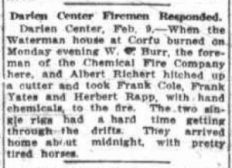 A few days earlier, “When the Waterman house at Corfu burned on Monday evening,” reported the February 9 Batavia Daily News, five firemen at Darien Center gamely hitched up sleighs and headed to the trouble. “The two rigs had a hard time getting through the drifts,” the Daily reported. “They arrived home about midnight, with pretty tired horses.”
A few days earlier, “When the Waterman house at Corfu burned on Monday evening,” reported the February 9 Batavia Daily News, five firemen at Darien Center gamely hitched up sleighs and headed to the trouble. “The two rigs had a hard time getting through the drifts,” the Daily reported. “They arrived home about midnight, with pretty tired horses.”
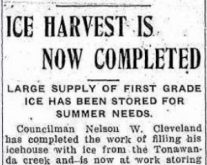 Then too, there is a silver lining in every cloud, or in this case tons of ice in a frigid winter. “Councilman Nelson W. Cleveland . . . is now at work storing a large shed with about eighty tons of additional ice,” reported the
Then too, there is a silver lining in every cloud, or in this case tons of ice in a frigid winter. “Councilman Nelson W. Cleveland . . . is now at work storing a large shed with about eighty tons of additional ice,” reported the 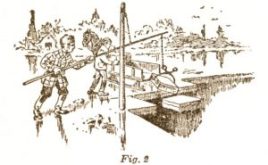 February 24 Batavia Times. “The second cutting was eleven and twelve inches in thickness. . . . At East Pembroke, where only one cutting was made on the Tonawanda creek . . . ice which measured 28 inches in thickness was taken.”
February 24 Batavia Times. “The second cutting was eleven and twelve inches in thickness. . . . At East Pembroke, where only one cutting was made on the Tonawanda creek . . . ice which measured 28 inches in thickness was taken.”
Weather-wise, March came in like a lamb, promising spring soon. Not even a brief snowfall on the 5th dampened the county’s anticipation.
“The snowfall will be of much benefit to the wheat crop, which is reported to be wintering in good condition,” opined a West Bethany correspondent in the March 6 1917 Batavia Daily News. “New seedings and meadows will also be protected from the cold.”

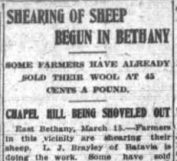 By mid-March, the signs of spring were everywhere. Robins were spotted in Corfu, LeRoy, and Bergen. In Bethany, shearing of sheep was begun. In North Byron, reported the March 24 Batavia Daily News, “Charles Searis has tapped his sugar bush.”
By mid-March, the signs of spring were everywhere. Robins were spotted in Corfu, LeRoy, and Bergen. In Bethany, shearing of sheep was begun. In North Byron, reported the March 24 Batavia Daily News, “Charles Searis has tapped his sugar bush.”
Yes, all would’ve been well in Genesee County in 1917 as winter made its welcome exit and spring’s long-awaited renewal arrived, bringing a fresh start, a fresh season.
All would’ve been well, that is . . . except for . . . the Kaiser.
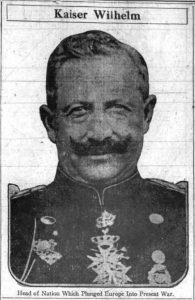
Day after day in February and March of 1917, nature’s cadence from winter toward the edge of spring in Genesee County was overshadowed by a darker sort of rhythm, a relentless beat orchestrated by the Kaiser and his minions toward the edge of war.
February 1: Germany resumes unrestricted submarine warfare.
“Situation Is Grave”
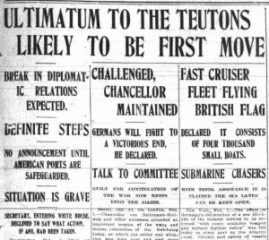 February 1, 1917 Batavia Daily News
February 1, 1917 Batavia Daily News
“Germany’s statement means that her submarines have been unleashed for unrestricted operations and henceforth all traffic by sea–neutral or enemy–within a proscribed zone, will be endangered.”
February 2, 1917 Batavia Daily News 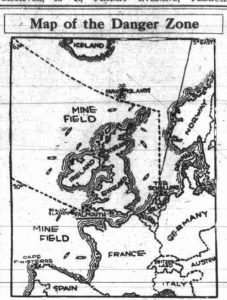
“Tonight or tomorrow the American people may know the course their government has decided upon.”.
February 3: The United States breaks diplomatic relations with Germany.
“These Are Days of Anxious Waiting”
February 3, 1917 Batavia Daily News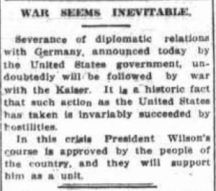
“It is a historic fact that such action as the United States has taken is invariably succeeded by hostilities.”
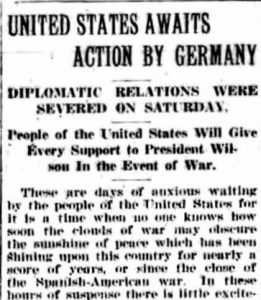 February 7, 1917 LeRoy Gazette-News
February 7, 1917 LeRoy Gazette-News
“These are days of anxious waiting for the people of the United States for it is a time when no one knows how soon the clouds of war may obscure the sunshine of peace . . . . In these hours of suspense there is little excitement because the people of this country are looking at the matter with a determined purpose to face whatever may come with courage and confidence.”
February 8: 45 ships reported sunk by German submarines in seven days.
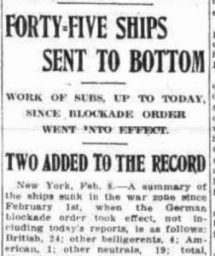 February 8, 1917 Batavia Daily News
February 8, 1917 Batavia Daily News
Throughout February and March, hardly a day passed when local newspapers didn’t report at least one more ship sunk, more lives lost. Germany’s strategy: to cut off food and war supplies to England and its allies, forcing a surrender within six months.
February 26: Ocean liner Laconia torpedoed without warning with 281 aboard; 10 Americans killed.
“A Clear Violation of American Rights”
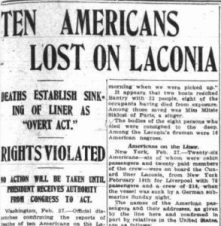 February 27, 1917 Batavia Daily News
February 27, 1917 Batavia Daily News
“The first torpedo struck near the stern and when the vessel was struck a second time she listed quickly to starboard.”
March 1: “Zimmermann Telegram” reveals secret German plot to enlist Mexico and Japan in war against U.S.
“We Shall Make War Together . . . It Is Understood that Mexico Is to Reconquer the Lost Territory in New Mexico, Texas and Arizona.”
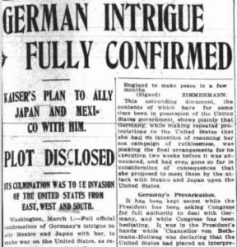 March 1, 1917 Batavia Daily News
March 1, 1917 Batavia Daily News
“Revelation of how Germany, expecting war with the United States as the result of her submarine campaign of ruthlessness, plotted to unite Mexico and Japan with her for an attack on the United States has stirred the capital to its depths.”
The telegram from Germany’s foreign minister, Alfred Zimmermann, to his counterpart in Mexico City was transmitted in code on January 19. The message was intercepted and decoded by British intelligence, and passed along to the United States. Although neither Mexico nor Japan was found to be complicit in the plan, the telegram provoked outrage throughout the country when it was released to the public on March 1.
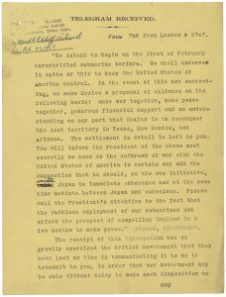
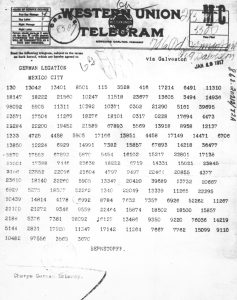
March 8: German admiralty announces 47 more ships sunk by its submarines in recent days.
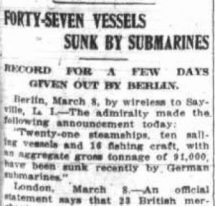 March 8, 1917 Batavia Daily News
March 8, 1917 Batavia Daily News
Germany’s stepped-up campaign of aggressive submarine warfare against shipping bound for Britain or its allies was clearly taking a toll. Weekly reports such as this one suggested that the admiralty’s effort to cut off food, ammunition, and medical aid was threatening to succeed.
March 10: President Wilson orders all merchant ships armed.
“Guns, Gunners and Ammunition Will Be Placed Aboard American Merchant Ships Immediately”
March 10, 1917 Batavia Daily News 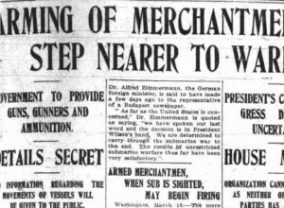
” . . . they will be sent to sea under orders to fire on German submarines . . . . The mere appearance of a German submarine in the presence of an American armed merchant vessel would entitle that ship . . . to take all measure for protection. . . . ”
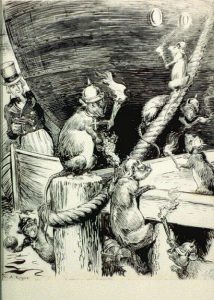
Remainder of March: Submarine attacks continue, outrage grows. The nation gears up for war.
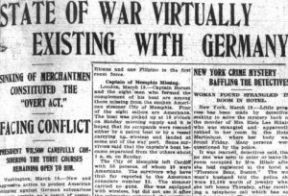 As March wore on,
As March wore on, 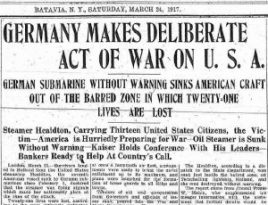 every day seemed to bring news of more sinkings, more Americans killed, less hope of peace. The March 19 Batavia Daily News (left) reported three unarmed American ships sunk the day before. On March 24, the Batavia Times (right) reported 21 lives lost when the U.S. steamship Healdton was torpedoed. Among the dead were seven Americans.
every day seemed to bring news of more sinkings, more Americans killed, less hope of peace. The March 19 Batavia Daily News (left) reported three unarmed American ships sunk the day before. On March 24, the Batavia Times (right) reported 21 lives lost when the U.S. steamship Healdton was torpedoed. Among the dead were seven Americans.
“The Time When Every Man Must Be a Patriot Has Come.”
The nation’s patience was worn thin. There seemed little doubt that the United States would soon be at war. National Guard units such as Buffalo’s 3rd Field Artillery and 74th 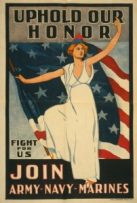 Infantry Regiment,
Infantry Regiment, 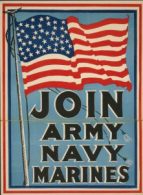 which included Genesee County men, were called up to protect bridges, power plants, and shipyards. Enlistment offices opened. And impassioned editorials in local papers reflected the nation’s growing patriotic fervor.
which included Genesee County men, were called up to protect bridges, power plants, and shipyards. Enlistment offices opened. And impassioned editorials in local papers reflected the nation’s growing patriotic fervor.
March 28, 1917 Batavia Daily News 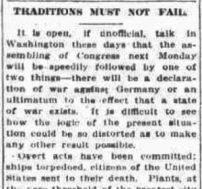
“The time when every man must be a patriot has come. Men of the United States of America must now take their stand. There is only one way to face, there is only one path to take. The way to face is toward liberty and freedom. The path to take is our country’s.”
President Wilson would soon address Congress at an emergency special session, called for April 2, regarding “the German situation.” The nation waited to hear what course of action the President would take. But deep down, nearly everyone in Genesee County, indeed most Americans, already knew.
Next: “Months of fiery trial and sacrifice ahead”
Credits
“Getting on His Nerves?” C.D. Dana (LC-DIG-ppmsca-33521); “Sailors and Others in a Lifeboat,” Frank Branqwn, U.S. Navy Recruiting Bureau (LC-USZCR-11363); “Time to Shoot” W.A. Rogers ((DLC/PP-1932:0042)); “Uphold Our Honor,” New York: Hegeman Printing Company (LC-USZC4-8307); “Join Army Navy Marines” (LC-USZC4-8309): Courtesy of the Library of Congress, Prints and Photographs Division.
“Kaiser Warning Uncle Sam” J.M. Stanforth: Courtesy of “Cartooning the First World War” project at Cardiff University.
Zimmerman Telegram as Received by the German Minister to Mexico, “Telegram from Secretary of State Robert Lansing to the American Embassy, London, 3/1/1917” (ARC 302025); and Zimmerman Telegram Translation, “Telegram from Ambassador Walter Page to Secretary of State Robert Lansing 2/24/1917” (page two, ARC 302022):
Record Group 59, General Records of the Department of State, 1763-2002, National Archives Catalog, accessed online https://catalog.archives.gov/id/[enter ARC NUMBER].
Newspaper clips: Courtesy of fultonhistory.com.
